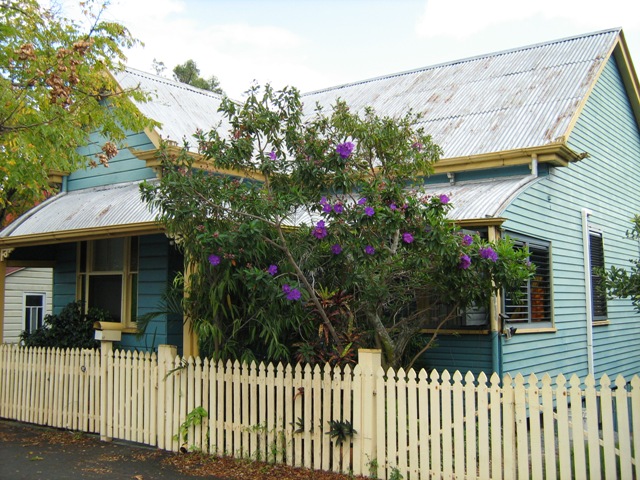Addresses
Type of place
House, Work residence
Period
Victorian 1860-1890
Style
Queenslander
Addresses
Type of place
House, Work residence
Period
Victorian 1860-1890
Style
Queenslander
This house was constructed circa 1881 for watchmaker Neels Peter Johnson. The residence became his workplace in 1884, but was leased to tenants after his death in 1890. Later called ‘Kimberley’, it was home to a series of tenants through the twentieth century. The house reflects the growth in the Valley’s residential settlement in the 1880s, as workers built homes on small allotments near their workplaces.
Also known as
Kimberley
Lot plan
L39_RP9237
Key dates
Local Heritage Place Since —
Date of Citation —
Construction
Roof: Corrugated iron;Walls: Timber
Criterion for listing
(A) HistoricalInteractive mapping
Also known as
Kimberley
Lot plan
L39_RP9237
Key dates
Local Heritage Place Since —
Date of Citation —
Construction
Roof: Corrugated iron;Walls: Timber
Criterion for listing
(A) HistoricalInteractive mapping
History
This is among the many residences built in this and the adjoining streets as the population, commerce and industries of Fortitude Valley expanded rapidly in the 1870s and early 1880s.
The slopes on which the residence is situated were undoubtedly familiar to the several North Brisbane Tribes which used the New Farm peninsula and ‘Binkinba’ as a favoured hunting ground. They formed an integral part of the vast stretch of ‘open undulating forest’ which Surveyor Wade depicted in his 1844 map.
While land closer to the river was surveyed and sold within several years of the Moreton Bay District being thrown open to ‘free settlement’, the sloping land of which this site forms a part was not acquired until 1861 when Governor Fitzroy ceded the parcel of 102 acres by Deed of Grant to James Gibbon an urban property speculator and a recent arrival in the new colony.
Gibbon constructed and resided in ‘Teneriffe’, atop a nearby hill, and named the rest of his land the ‘Teneriffe Estate’. He began selling parcels of the land in the 1870s, including this section in what was then known as Stratton Street. The area quickly became occupied with small houses and cottages, their occupants drawn by the proximity to workplaces in the Valley and the comparative affordability of the land.
Watchmaker Neels Peter Johnson purchased this 18.4 perch site in 1880. Johnson had been declared insolvent three years earlier in Ipswich, but removed to Brisbane and opened a new shop in Fortitude Valley. By 1881 he was living in Wickham Street, from where he called for tenders for the erection of a ‘small cottage’ in November.
The establishment of this part of Arthur Street as a residential area in the mid-1880s reflects the population boom Brisbane experienced at this time. Between 1881 and 1891 Brisbane’s population increased from 37,000 to 100,000. More than half the increase in metropolitan population during the period 1881-86 was concentrated in Spring Hill, the Valley, Newstead and South Brisbane.
The densely packed houses of working men and women were predominant in the Valley. To cater for the influx of working class families new housing was built on tiny allotments in narrow streets where speculators had divided estates into the maximum possible number of blocks of land. This house was built to maximise its small allotment, being built almost to the front alignment of the block.
Johnson moved into his Arthur Street residence by 1884 when he announced to his customers that, in consequence of his ill-health, he would be working from home. Johnson mortgaged the property six times throughout the 1880s for amounts ranging from forty to six hundred pounds. By this time he had moved again, possibly due to his health, and in 1890 he died at his Nundah residence. His estate retained the house, which was leased to a series of tenants. The ‘neat villa residence’ was offered for sale in November 1908. Advertisements emphasised its advantages, including seven rooms and laundry.
William Baird became the new owner of the house, but after his death in 1910 the property passed to his brother Samuel. The latter became an Arthur Street resident, moving into a property across the road from this house, and leased it to tenants. Similarly, another Arthur Street resident purchased the property after Samuel’s death in 1934 and leased it while living nearby.
Oral history sources have suggested that this house was once a post office and that the existing houses at 194 and 196 Arthur Street were used as a police residence and a police station/lockup, respectively. Research to date has neither confirmed nor denied this suggestion. Further research may do so.
Description
This house is a reasonably intact timber workers cottage of a non-standard design with a projection front room almost on the street alignment.
Statement of significance
Relevant assessment criteria
This is a place of local heritage significance and meets one or more of the local heritage criteria under the Heritage planning scheme policy of the Brisbane City Plan 2014. It is significant because:
References
-
Allom Lovell Architects, 192-194 Arthur Street Fortitude Valley: A conservation report for Mondo Architects, 2003
-
Brisbane City Council Archives, Surveyors’ Notebook, 1916 and 1927
-
Brisbane City Council, aerial photographs, 1946, 2001
-
Brisbane City Council City Architecture and Heritage Team, citations
-
Brisbane City Council, Properties on the Web, Building Cards
-
Brisbane City Council Water Supply and Sewerage Detail Plans
-
Brisbane City Council, Fortitude Valley study
-
Daily Sun, 1986
-
Department of Natural Resources and Mines, Queensland Certificates of Title
-
NLA, Trove website, Brisbane Courier, Telegraph
-
Queensland Post Office Directories
-
Queensland Births, Deaths and Marriages
Citation prepared by — Brisbane City Council (page revised September 2020)

